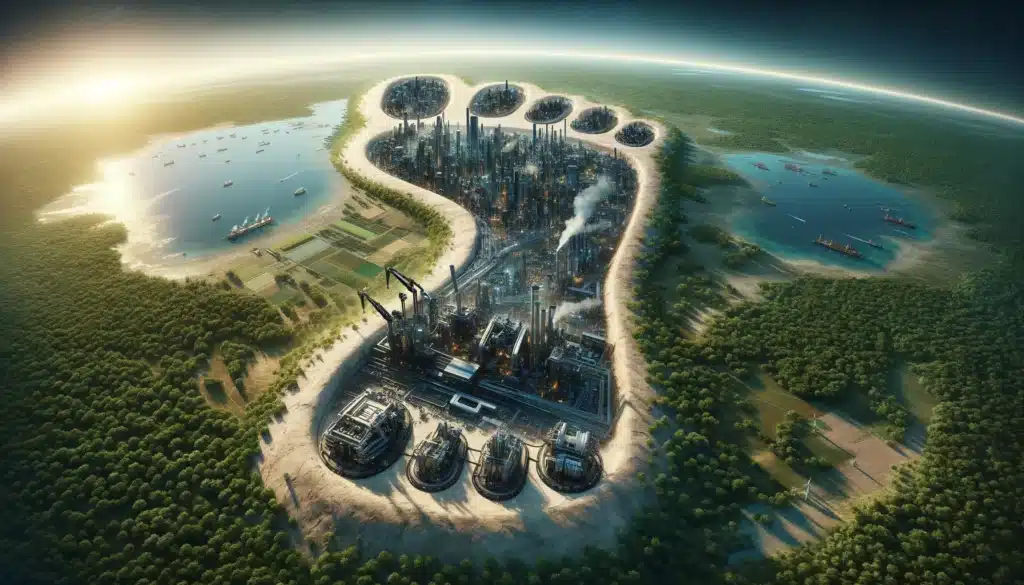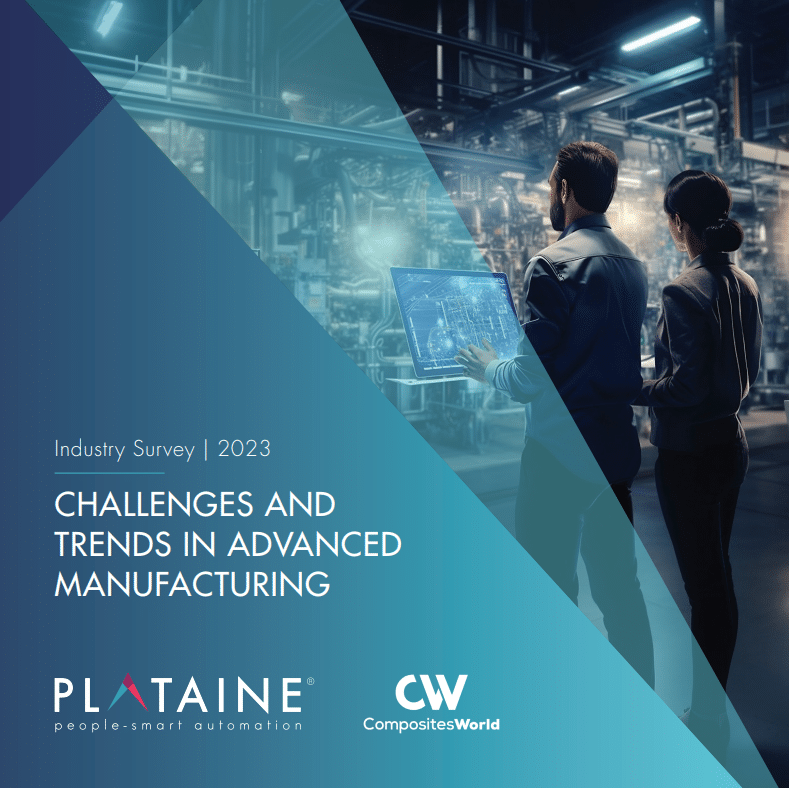Manufacturing has come a long way since the industrial revolution, but along with the incredible progress, it has also left a substantial carbon footprint on our planet. In today’s world, where environmental concerns are at the forefront, it’s crucial for the manufacturing industry to adopt sustainable practices. Sustainability in manufacturing is not just a buzzword; it’s a necessity for the well-being of our planet. In this blog post, we’ll explore the benefits of sustainability in manufacturing, strategies for achieving sustainable manufacturing practices, sustainability metrics for measuring progress, and the pivotal role of IIoT and AI technology in driving sustainability.
In a recent industry survey, conducted by Plataine and distributed by CompositesWorld, aimed at providing insights into certain aspects of the composites industry, particularly the challenges faced by manufacturers, and the strategies embraced by leading companies to overcome these issues, it was found that achieving sustainability standards is a critical focus for the industry. The survey delved into the efforts made by companies to meet sustainability goals, such as reducing carbon emissions, optimizing material usage, and implementing circular economy practices. Leading companies are actively investing in sustainable manufacturing practices and exploring innovative solutions to minimize their environmental footprint. The need for sustainable manufacturing and achieving sustainability standards continues to evolve, with 23% of respondents acknowledging it as a significant challenge.
When asked if respondents felt pressure from government or regulatory authorities to improve sustainability at their facilities, it became apparent that manufacturers are under global pressure to emphasize environmental sustainability and achieve net-zero emissions. Discrete manufacturers are leveraging their expertise in optimizing products, improving processes, collaborating across the supply chain, and implementing advanced digital capabilities to rapidly reduce the carbon footprints of their operations and enhance their buy-to-fly ratio. A significant 53% of medium-sized companies have heard about plans to regulate manufacturing processes but do not yet feel the pressure. Meanwhile, 45% of medium-large companies report that regulations are being felt. These regulations are most pronounced among large companies, particularly those with over 5000 employees, where strict deadlines for sustainability compliance are being published and actively enforced.
Get the full Survey Report here:
Benefits of Sustainability in Manufacturing
- Environmental Conservation
One of the most significant advantages of embracing sustainability in manufacturing is the positive impact on the environment. Sustainable manufacturing practices reduce greenhouse gas emissions, conserve resources, and minimize waste generation. By adopting eco-friendly processes, manufacturers can contribute to a cleaner, healthier planet for future generations.
- Cost Savings
Sustainable manufacturing isn’t just about being eco-conscious; it’s also about saving money. Reducing energy consumption, optimizing resource usage, and minimizing waste all lead to significant cost savings. Manufacturers can lower their operational expenses while still producing high-quality products.
- Enhanced Reputation
Consumers today are more environmentally aware and socially responsible. Companies that prioritize sustainability not only attract eco-conscious customers but also build a positive reputation. A commitment to sustainable manufacturing can differentiate a brand in a competitive market and foster customer loyalty.
- Compliance with Regulations
Governments and regulatory bodies worldwide are implementing stricter environmental standards. Sustainable manufacturing practices help companies stay compliant with these regulations, avoiding fines and legal issues.
Sustainable Manufacturing
When it comes to sustainable manufacturing, having the right strategies in place can make a world of difference. Sustainable manufacturing is all about adopting eco-friendly materials, boosting energy efficiency, reducing waste, and optimizing the supply chain. And to make sure we’re on the right track, we keep an eye on metrics like our carbon footprint, energy consumption, water usage, waste generation, and the full lifecycle of our products. These strategies and metrics are the building blocks for a greener and more sustainable future. Let’s break down some key strategies that manufacturers are adopting to reduce their environmental footprint.
Eco-Friendly Materials: The journey to sustainable manufacturing begins with the materials we use. Opting for eco-friendly materials is a fundamental step. This means choosing materials that have a minimal environmental impact. Think recycled materials, reducing the use of harmful substances, and getting materials from responsible suppliers. It’s all about making choices that are kinder to the planet.
Energy Efficiency: Another big strategy is improving energy efficiency. This involves upgrading our machines, fine-tuning our processes, and, where possible, harnessing renewable energy sources. By doing this, we can cut down on energy consumption and reduce those carbon emissions that harm our environment.
Waste Reduction: Waste not, want not, they say. Minimizing waste generation and maximizing recycling efforts are at the heart of sustainable manufacturing. Ever heard of a circular economy? It’s a concept where products are designed for reuse and recycling, which cuts down on waste and makes the whole manufacturing process greener.
Supply Chain Optimization: Sustainability doesn’t stop at the factory gate; it extends all the way down the supply chain. To truly make a difference, manufacturers are teaming up with their suppliers and distributors to ensure everyone plays their part. This includes cutting down on transportation emissions, smart logistics, and promoting eco-friendly practices throughout the supply network.
Now, let’s talk about how we keep track of our progress in these sustainability efforts.
Carbon Footprint: Imagine if we could measure the environmental impact of our manufacturing processes. Well, we can, and it’s called the carbon footprint. This nifty metric quantifies the amount of carbon dioxide and other greenhouse gases emitted during manufacturing. The goal? To reduce this footprint by using cleaner energy sources and optimizing our operations.
Energy Consumption: Monitoring how much energy we use is another key metric. By keeping an eye on our energy consumption, we can pinpoint areas where we can do better. Not only does this save us money, but it also reduces our environmental impact.
Water Usage: Manufacturing often involves a whole lot of water. Tracking how much water we use and finding ways to use less is crucial for sustainability. Water-saving technologies can help us minimize our impact on the environment.
Waste Generation: Nobody likes waste, especially when it’s harmful to the environment. Sustainable manufacturers aim to cut down on waste by implementing recycling programs, finding creative ways to reuse materials, and reducing unnecessary packaging.
Product Lifecycle Analysis: Ever wondered about the full journey of a product, from its raw materials to how it’s used and eventually disposed of? That’s what product lifecycle analysis is all about. Understanding this entire journey helps us make sustainable choices at every stage, from production to disposal.
The Role of IIoT and AI Technology in Driving Sustainability
The role of AI and IIoT in reaching new standards and driving sustainability
Naturally, AI and IIoT are leveraged in the composite manufacturing industry in order to enhance material savings, reduce waste and increase throughput while minimizing energy consumption.
Besides its crucial role in saving money and increasing profitability, Industry 4.0 tech is playing a pivotal role in advancing sustainability in manufacturing. Here’s how:
Predictive Maintenance: Imagine having a crystal ball that tells you when your machines are going to break down. Well, AI-powered predictive maintenance is like having that crystal ball. It uses fancy algorithms to predict equipment failures before they even happen. This is a big deal because it means less downtime for factories. When machines break, it’s not just about fixing them; it’s also about wasting energy and materials. Predictive maintenance helps us catch problems early, saving energy, and making machines last longer – all of which is super sustainable.
Process Optimization: AI is a bit like a detective when it comes to manufacturing. It looks at a mountain of data and figures out where things could be done better. This means fewer mistakes, less wasted energy, and less stuff ending up as trash. When we optimize our manufacturing processes with AI, it’s like tuning up a car for better gas mileage – it’s good for the environment and our wallets.
Supply Chain Efficiency: Think of AI as your trusty navigator for the manufacturing supply chain. It helps us make really smart decisions about things like how to transport stuff, how much stuff to keep in stock, and where to get our materials from. When we make these decisions with AI’s help, we’re not only saving money but also cutting down on carbon emissions. It’s like taking the shortest route to your destination – you get there faster and
and with less gas wasted. AI is like that GPS for the supply chain, helping us be more sustainable.
Manufacturing Sustainability Trends: check out the recent sustainability trends in our recent survey report here
Sustainability in manufacturing is always evolving, and it’s important for manufacturers to keep up with the latest trends if they want to reduce their impact on the environment.
One hot trend is the “Circular Economy.” It’s all about reducing waste and making sure products don’t end up in the trash too soon. Manufacturers are designing things to last longer and finding clever ways to recycle and reuse materials.
Another trend is switching to “Renewable Energy.” Instead of using fossil fuels that harm the planet, more manufacturers are turning to clean sources of power like solar and wind energy. It’s like saying goodbye to dirty energy and hello to a greener future.
Then there’s “Sustainable Packaging.” You might notice that packages are getting more eco-friendly. Think biodegradable materials and simpler designs that use less stuff. Manufacturers are rethinking how they package things to create less waste.
“Green Supply Chains” are also on the rise. That means not just the factory but the whole journey from making stuff to getting it to your doorstep is becoming greener. They’re finding better ways to move things around, using less packaging, and promoting sustainability along the way.
Lastly, using “Eco-Friendly Materials” is gaining popularity. Manufacturers are saying no to materials that harm the environment and yes to ones that are kinder. They’re actively looking for alternatives to the old stuff that caused problems for the planet.
These trends show that manufacturers are taking big steps to be more eco-friendly. It’s not just about making products; it’s about making the world a better place, one sustainable choice at a time.
In conclusion, sustainability in manufacturing is not just an ethical choice; it’s a strategic imperative. Embracing sustainable manufacturing practices offers numerous benefits, including cost savings, environmental conservation, and improved reputation. As portrayed in the survey report that shed light on the global pressure faced by manufacturers to emphasize environmental sustainability and achieve net-zero emissions. Companies are leveraging their expertise in optimizing products, improving processes, and adopting advanced digital capabilities to swiftly reduce their carbon footprints To achieve sustainability goals, manufacturers must adopt eco-friendly materials, enhance energy efficiency, reduce waste, and optimize their supply chains. Moreover, AI technology plays a pivotal role in driving sustainability by enabling predictive maintenance, process optimization, and sustainable product design. As sustainability in manufacturing continues to evolve, staying informed about the latest trends and metrics is crucial for success in this increasingly eco-conscious world. By taking proactive steps towards sustainability, manufacturers can pave the way for a greener, more sustainable future.










